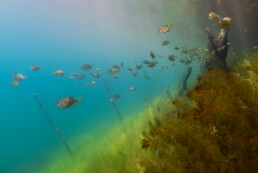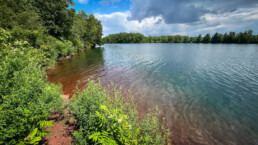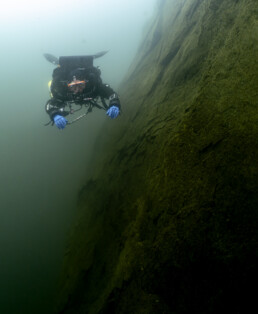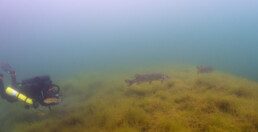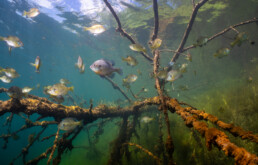The Quest for Cuyuna’s Flamingos
I appear to be diving on Mondays with such predictable regularity that my phone, with eerie clairvoyance, now auto-loads directions to Heather’s house before I’ve even left the driveway. It’s a little funny, in the same way it’s funny that your phone might someday apply for a mortgage on your behalf.
With both of us blessedly free for the day, Heather and I decided to explore a new site in Cuyuna Country. Our mission: to locate the elusive flamingos. Not real flamingos, of course—Minnesota’s climate isn’t exactly known for hosting subtropical birds—but rather the pink plastic kind that allegedly grace the shallows of one of Crosby’s many flooded mining pits. The intel came from Facebook, that magnificent digital repository where misinformation goes to flourish like bacteria in a petri dish of human gullibility.
The site in question was called “Connecticut 2-Bit” in the Huntington Pit, a name that may refer to obscure mining slang or the title of a long-lost poker game. Either way, we were intrigued. We loaded everything into Heather’s dainty Subaru, which sips fuel politely, unlike my SUV—a vehicle Heather insists measures fuel economy in “gallons per mile.”
The road in was classic northern Minnesota—muddy, axle-deep, and clearly engineered by someone who drinks Budweiser for breakfast and measures success by how much mud they can sling in their lifted truck. It was lined with an enthusiastic mix of poison ivy, low-hanging branches, and an army of wood ticks. I collected two before I even closed the car door. Heather’s Subaru Impreza, bless its city-car soul, crept along like it was sneaking past a sleeping bear. We eventually reached a clearing that passed for a parking spot, and from there followed a narrow trail to the shoreline, where there was a gentle entry into delightfully clear, calm water.
By the time we finished wrangling ourselves into undergarments and drysuits, we were effectively slow-roasting in our own sweat. It was sunny, mid-70s, and the nearest shade was probably in Canada. So, in the name of not melting, We waded in—dry-gloved, zipped up, but blissfully gear-free.
The water hit like a cold cloth to the forehead—glorious on the face, merely suggestive everywhere else. Picture trying to cool off while wrapped in a quilt inside a wool long underwear. As I floated, I remembered a video where someone demonstrated how to practice the elusive back-kick. A sort of reverse drive, it’s the aquatic equivalent of parallel parking—elegant when done right, awkward when not. Cave divers rely on it, and for photographers, it’s a lifesaver when framing a shot an inch too close.
So I gave it a go. A bit of flailing, but with some effort I adjusted my positioning and leg control like a break dancing diver in slow motion. I didn’t set any speed records, but I moved backwards with intention, slightly—and dignity mostly intact. Not bad for a pre-dive warm-up.
Eventually, we suited up and entered the water properly. Huntington is one of those deep, narrow pits where navigation is blissfully simple: wall on the left going out, wall on the right coming back. We were both on partially used scrubber material, so we planned for a conservative two-hour dive.
Given that it was a Monday and the lake had only canoe access, the likelihood of getting hit by a powerboat was effectively zero, so I tied off our dive flag on a submerged tree just after descending—helpful for locating our exit point, I thought. It wasn’t.
At 70 to 80 feet, the lakebed plummeted away beneath us into shadowy oblivion. The deeper you go, the greener and more otherworldly the light becomes. Hovering beside that sheer drop, suspended in silence and 41°F water, I was reminded of why I dive. It’s the feeling of being somewhere entirely alien—even though you’re technically just down the road from a Kwik Trip.
After a half hour hovering along the near sheer wall of Huntington Pit, I signaled to move up. We rose from the murk into a world transformed—up into the shallows, where sunlight streamed through like gold leaf in suspension. Visibility had opened up to a generous 30, maybe 40 feet, and with the sun out in full force, the lake looked almost Mediterranean, if you squinted hard enough and ignored the panfish.
Bass cruised by in lazy patrols, unconcerned, and a pair of Northern Pike drifted past like nuclear submarines in stealth mode—both nearly the size of Heather, which, for the record, is no exaggeration. I managed a quick frame with her in the background for scale—no artistic masterpiece, but a decent documentary photo nonetheless.
This sort of encounter is precisely why I put in the time, money, and mildly obsessive energy to learn rebreathers. They’re finicky, yes—part scuba gear, part spacecraft—but their near-silent operation transforms the dive experience. No clouds of bubbles, no fizzy soundtrack. Just quiet. And that, it turns out, makes all the difference when you’re trying to approach animals that have spent millennia living in a near-silent world.
The stealth that a rebreather affords isn’t just practical—it’s peaceful. You don’t swim so much as drift. And with fish that would normally flee at the first pop of a regulator exhaust, you find yourself eye to eye—close enough to count scales. As photographer Alex Mustard puts it, if you can’t reach out and touch your subject, you’re probably too far away to make a compelling image. Today, I could have extended a hand. I didn’t, of course. But I could have. And that’s the quiet magic of it.
After about 45 minutes, we made the turn and began the swim back, staying in the shallows where the light was best and the scenery most cooperative. From a photographic standpoint, it was ideal—dappled sunlight, vivid colors, fish that practically lined up for portraits. From a buoyancy perspective, however, the shallows are where things get interesting.
At depth, changes in buoyancy happen gradually—gentle, manageable. But in ten to fifteen feet of water, the gas in your loop and wing expands with the enthusiasm of a child filling a balloon, and even small adjustments can launch you toward the surface with surprising speed. Managing this while also composing shots and coaxing wary subjects into the frame becomes a sort of multitasking ballet.
There were moments that required a swift and deliberate venting of gas to arrest an unplanned ascent. But that’s part of the CCR learning curve—shallow water requires precision, and precision comes with time. Still, if you want dramatic light and close encounters, this is where the payoff lives.
On the long, meandering swim back, I managed a few frames of schooling panfish that I actually rather liked—tight formations with the kind of symmetry and light that photographers wait entire dives for. Heather, being newer to rebreathers than I am, was perfectly content to focus on buoyancy and loop control, which gave me time to chase compositions I never quite nailed but enjoyed pursuing all the same.
By the two-hour mark, we still hadn’t passed the dive flag I’d tied off earlier in what I had confidently declared was twenty-five feet of water. Both of us were stretching into the polite margins of our scrubber time, so we surfaced for a quick orientation check—and found ourselves in the middle of what can only be described as a panfish daycare.
Dozens of bluegill nests spread out in every direction, with territorial males flaring their gills and posturing like bouncers at a nightclub. I’ve swum through nesting zones plenty of times, but their determined little theatrics never get old. We spent a few minutes enjoying the scene before realizing we’d overshot the flag—and our exit—by a couple hundred yards.
We dropped back down to about fifteen feet and began the swim back, only to discover that my original tie-off had been considerably deeper than I’d remembered—closer to forty feet, tucked just below our shallow return path. We had swum right past it earlier, eyes up and oblivious, while the flag reel sat quietly below—exactly where I left it, just not quite where I thought.
We retrieved the flag, emerged onto dry land feeling 100 pounds heavier (because we were), and began the slow, grunting ritual of gear removal. Heather observed that the ominous clouds above would surely burst the moment we unzipped our suits. Which they did, precisely on cue. A brief sun shower—just long enough to dampen everything and annoy us.
The ride home always feels longer, probably because the anticipation is spent. I passed the time with a warm peanut butter and jelly sandwich, some gas station snacks, and a deep-dive conversation about niche rebreather configurations that could euthanize any cocktail party.
Oh, and the flamingos? Never saw them. Not one pink feather. Another Facebook fantasy. But the wall was real. The pike were impressive. And the peanut butter sandwich was, honestly, pretty outstanding.

